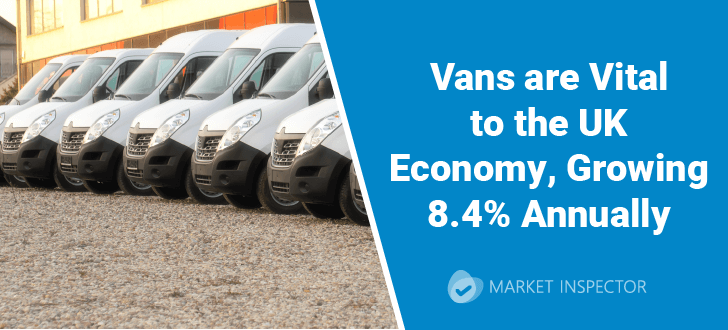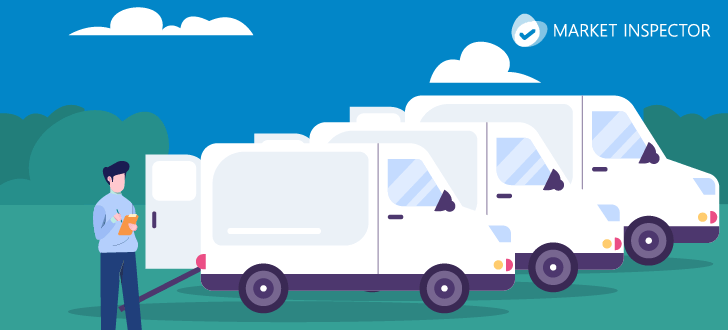Answer these simple questions and we will find you the BEST prices
Which type of solar quotes do you need?
It only takes 30 seconds
100% free with no obligation

Get up to 4 quotes from our selected suppliers by filling in only 1 form

Save money by comparing quotes and choosing the most competitive offer

Our service is 100% free and with no obligation
- Market-Inspector.co.uk
- Vehicle Tracking
- Van tracking
Is Van Tracking The Best Solution For Your Business?


- Van tracking systems are a worthwhile investment for businesses looking to optimise their operations, improve security, and reduce costs.
- Vans play a crucial role in the UK economy, with data from the Society of Motor Manufacturers and Traders (SMMT) revealing that the light commercial vehicle market has grown by 8.4% year-on-year.
- Van tracking involves using GPS technology to monitor and manage a fleet of vans. A van tracking device, typically installed in each vehicle, communicates with satellites to provide real-time data on the vehicle's location, speed, and route.
Implementing van tracking systems significantly benefits businesses that use vans for deliveries and services. Fleet tracking software offers real-time tracking and dispatch, optimising routes for faster deliveries and better customer service.
Monitoring driver behaviour reduces fuel costs by minimising speeding and idling. Tracking habits promote safer practices and enhance driver safety. Automated service reminders and maintenance schedules prevent breakdowns, improving fleet management. Real-time location tracking increases security, preventing theft and enabling quick recovery of stolen vehicles.
Overall, van tracking devices streamline operations, reduce costs, and enhance safety and security, giving businesses a competitive edge.
- Describe your needs
- Get free quotes
- Choose the best offer
It only takes 30 seconds

Choosing the right van tracker

Selecting the appropriate van tracker for your fleet is crucial to maximising the benefits of van tracking systems. Here, we'll introduce the basic differences between various types of tracking devices, focusing on the type most commonly used for vans and explaining why it is preferred.
Let’s examine the different van tracking devices available and their associated benefits and disadvantages.
Plug-and-play trackers
These van tracking devices plug directly into the vehicle's OBD-II port. They are easy to install and typically do not require professional assistance.
- Advantages: Quick installation, cost-effective, and easily transferable between vehicles.
- Disadvantages: They can be more easily tampered with or removed and may not offer as many features as hardwired trackers.
Hardwired trackers
These devices are directly connected to the vehicle’s electrical system and are usually installed behind the dashboard or in another concealed location.
- Advantages: More secure and harder to tamper with, offering robust features like engine diagnostics, driver behaviour monitoring, and advanced anti-theft measures.
- Disadvantages: Requires professional installation, which can be more costly and time-consuming.
Hardwired trackers are the most commonly used type for vans due to their reliability and comprehensive feature set. Here's why:
- Security and tamper-resistance: Hardwired van GPS trackers are installed in hidden locations within the vehicle, making them less accessible and harder to tamper with. This feature is crucial for preventing unauthorised removal or disabling of the device, ensuring continuous tracking and data collection.
- Advanced features: Hardwired trackers integrate seamlessly with the vehicle’s systems, providing detailed insights into vehicle performance and driver behaviour. Features like real-time location tracking, geofencing, route history, and maintenance alerts are standard. These features help fleet managers optimise routes, monitor fuel usage, and ensure timely maintenance, which can significantly reduce operational costs.
- Reliability: Powered directly by the vehicle’s electrical system, hardwired trackers do not rely on battery power, ensuring continuous operation without the risk of power loss. This reliability is essential for businesses that need constant, uninterrupted fleet tracking.
- Comprehensive data: These devices provide extensive data, including real-time tracking, speed monitoring, and diagnostic trouble codes. This information helps in proactive maintenance, enhancing vehicle lifespan and performance.
- Installation and cost considerations: While hardwired van tracking devices require professional installation, which can increase the initial setup cost, the long-term benefits often outweigh these costs. The enhanced security, advanced features, and reliability make hardwired trackers a valuable investment for businesses looking to optimise their fleet management.
- Durability: They are built to withstand harsh conditions and consistently perform over time.
- Extensive features: From detailed driver behaviour reports to real-time tracking and maintenance alerts, hardwired trackers offer a wide range of features that significantly benefit fleet management.
- Security: Their hidden installation and tamper-resistant features make them ideal for high-value assets that require continuous monitoring.
Overall, hardwired van tracking systems stand out as the optimal choice for businesses seeking the best van tracker. They offer unparalleled security, reliability, and a comprehensive suite of features that help enhance efficiency, reduce costs, and improve overall fleet management.
Best van tracking companies
Three vehicle tracking companies stand out for their reliability, features, and overall performance when choosing a van tracking system: Teletrac Navman, Quartix, and Webfleet. Each offers unique advantages suited to different business needs.
Teletrac Navman
Teletrac Navman is known for its comprehensive tracking solutions that cater to a wide range of business requirements. It is especially favoured by companies needing robust and scalable tracking systems.
- Comprehensive features: Offers various features, including real-time tracking, driver behaviour monitoring, and route optimisation.
- User-friendly interface: The platform is intuitive and easy to use, making it accessible for businesses of all sizes.
- Scalability: Suitable for small and large fleets, with scalable solutions to meet varying needs.
- Cost: Higher initial setup and subscription costs compared to some other providers.
- Complexity: The wide range of features can overwhelm smaller businesses with simpler needs.
Teletrac Navman is ideal for businesses that need a robust and scalable van-tracking solution with comprehensive features to enhance fleet management and efficiency.
Quartix
Quartix is a cost-effective solution that offers simplicity and reliability. It is an excellent choice for small to medium-sized businesses that need basic tracking without the complexity of more advanced systems.
- Cost-effective: Offers competitive pricing, making it a good choice for smaller businesses or those on a budget.
- Simplicity: Easy to install and use, with straightforward reporting and tracking features.
- Good customer support: Known for responsive and helpful customer service.
- Limited advanced features: These may lack some advanced features in more expensive systems.
- Basic reporting: While sufficient for many, the reporting tools may not meet the needs of businesses looking for in-depth analytics.
Quartix is ideal for businesses seeking a cost-effective and easy-to-use van tracking system without extensive advanced features.
Webfleet
Webfleet, previously known as TomTom Telematics, integrates advanced navigation with detailed data analytics. It best suits businesses looking for premium tracking solutions with extensive features.
- Advanced navigation: Integrates with TomTom’s navigation system, offering superior route planning and optimisation.
- Comprehensive data: Provides detailed analytics on vehicle usage, driver behaviour, and fuel consumption.
- Flexible plans: Offers various plans to suit business needs, from basic tracking to advanced fleet management.
- Higher cost: Premium features come at a higher price point.
- Complex setup: The initial setup can be more complex and require professional installation.
Webfleet is suitable for businesses that need advanced navigation and detailed data analytics and are willing to invest in a premium tracking solution for enhanced operational efficiency.
Considering the above, choosing the right van tracking system depends on your business needs and budget. A cheap vehicle tracker can be an excellent starting point for those prioritising affordability. Teletrac Navman is best for comprehensive features and scalability, Quartix is best for cost-effectiveness and simplicity, and Webfleet is best for advanced navigation and detailed data analytics. Comparing these options will help you find the most suitable and cost-effective solution for your van tracking needs.
How do you install a van tracking device?

You can install your tracker by hiring local mechanics, using installation-included systems or through DIY. We will take a look at each of these and then take a look at how to install the tracker yourself - a brief DIY guide.
Local mechanics
- Pros: Professional installation ensures the device is securely and correctly installed, reducing the risk of tampering or malfunction.
- Cons: It can be more expensive due to labour costs.
This installation method is ideal for businesses without in-house technical expertise or those seeking a hassle-free installation.
Installation-included systems
- Pros: Many tracking system providers offer professional installation packages, ensuring compatibility and correct setup.
- Cons: The overall cost can be higher but often includes both the device and installation fees.
The installation-included systems are best for those who want an all-inclusive service without coordinating with third-party installers.
DIY installation
- Pros: Cost-effective and allows for flexibility in scheduling.
- Cons: Requires a basic understanding of vehicle electronics and might not be as secure if not done correctly.
This installation type suits those with technical skills and a smaller budget. However, professional installation is generally recommended for optimal results.
DIY installation guide
Professional installation is recommended for best results. However, when considering a DIY installation, it is advisable to follow these steps:
- Gather tools and materials: a van tracking device, wiring kit, screwdrivers, wire strippers, electrical tape, and the vehicle’s manual.
- Choose a location: You can select hidden spots behind the dashboard, under the seats, inside the glove compartment, or beneath the vehicle body.
- Mount the device: Secure the device with screws or adhesive pads and ensure it is hidden.
- Test the device: Reconnect the battery, power the device, and verify data transmission through the app or web interface.
Why rely on professionals?
While DIY installation can be a cost-effective solution, professional installation is highly recommended for the following reasons:
- Expertise: Professionals have the necessary skills and experience to install the device correctly and securely.
- Security: A professional installation minimises the risk of tampering or malfunction, providing peace of mind.
- Warranty: Many providers offer warranties that might be voided by improper DIY installation.
Anti-theft and anti-tamper van trackers

Over the past four years, van thefts have risen from 4.36 stolen vans per 1,000 registrations in 2019 to 4.55 in 2022. Last year alone, DVLA data showed that over 11,000 vans were stolen in the UK. This 4.4% increase in van theft has had devastating effects on the mental health and work of businesses and drivers.
According to data from police reports, South Yorkshire tops the list as the leading hotspot for van thefts in the UK, with 14.07 stolen vans per 1,000 registered. Northumbria is the second most affected area, with a ratio of 12.69 per 1,000, while the London Metropolitan area ranks third, with 10.37 thefts per 1,000 vans.
Conversely, the Dyfed-Powys area in Wales has the lowest incidence of van thefts, with just 0.1 thefts per 1,000 registered vans. Other regions with a theft ratio below one include North Wales (0.47), Gloucestershire (0.66), Norfolk (0.7), and Suffolk (0.93).
How a tracker can get tampered
While highly effective, van trackers can sometimes be tampered with by individuals who do not want their movements monitored. Common tampering methods include:
- Signal jamming: Using devices that emit signals to interfere with the GPS signal, preventing the tracker from transmitting its location.
- Physical removal: Locating and physically removing the tracker from the vehicle.
- Power disconnection: Cutting the power supply to the tracker, especially if it is hardwired to the vehicle’s electrical system.
There are several reasons why an employee might want to tamper with a van tracker. Unauthorised personal use is one common motive. Employees might interfere with the tracker to use the vehicle for personal errands or trips without the company's knowledge.
Privacy concerns also play a significant role. Some employees might feel that constant monitoring is an invasion of their privacy and may try to disable the tracker to avoid feeling surveilled.
Importance of anti-theft and anti-tamper features
To combat tampering and theft, modern van tracking systems come with several anti-theft and anti-tamper features:
- Tamper alerts: Immediate notifications if the device is removed or tampered with.
- Backup battery: Ensures the tracker continues to operate even if disconnected from the vehicle’s main power supply.
- Tamper-proof casings: Robust housings that make it difficult to physically access the device.
By investing in van trackers with strong anti-theft and anti-tamper features, businesses can significantly reduce the risk of vehicle theft and unauthorised use, ensuring their assets are better protected.
Businesses that benefit the most from van tracking

Van tracking has become an indispensable tool for various UK businesses, particularly those in logistics, field service management, and construction. These companies have achieved significant cost savings, improved service quality, and increased customer satisfaction by optimising routes, improving security, and enhancing overall operational efficiency.
Logistics and delivery services
We have listed some benefits of van tracking for a logistics or delivery service company.
- Cost reduction: Companies report significant reductions in fuel costs, often up to 20%, due to optimised routing. This reduction is achieved by avoiding traffic jams, taking shorter routes, and planning fewer stops.
- Improved customer satisfaction: Real-time updates and accurate delivery times increase customer satisfaction. Customers appreciate knowing exactly when to expect their deliveries, reducing frustration and increasing trust in the service.
- Security: Implementing tracking systems has led to a notable decrease in vehicle-related thefts. For example, Royal Mail has seen a reduction in theft incidents, as tracking systems deter unauthorised use and facilitate quick recovery of stolen vehicles.
Construction
Research shows that 77% of businesses in the construction industry use a GPS tracking system. Let’s take a look at some advantages for business within construction:
- Asset utilisation: Companies see improved utilisation of their vehicles and equipment. Knowing where assets are at all times can help allocate them more effectively across different projects.
- Reduced downtime: Better scheduling and routing reduce downtime, allowing more continuous project work. This efficiency leads to faster project completion and cost savings.
- Safety: Monitoring driving behaviours and vehicle conditions helps reduce accidents and violations, leading to a safer work environment and lower insurance costs.
Healthcare
Healthcare businesses, particularly those involved in home health services (HHCS), benefit significantly from implementing GPS tracking systems in their fleets of vans. Here are some key advantages:
- Real-time location tracking: Knowing the real-time location of home caregivers enables healthcare businesses to deploy the nearest available aide to a patient in need. This capability is crucial in emergencies where timely care can significantly impact patient outcomes.
- Optimised routes: GPS tracking helps caregivers plan the most efficient routes, ensuring they spend more time providing care and less time travelling. This improves the overall productivity of the healthcare workforce.
- Enhanced patient care: Timely arrivals ensure caregivers arrive on time.
Case study: Royal Mail
Royal Mail has implemented van tracking systems to optimise its delivery routes and improve overall efficiency. By 2023, Royal Mail expanded its electric van fleet to 5,500 vehicles, part of its goal to achieve net zero emissions by 2040.
This deployment led to a 10% reduction in fuel costs and significantly improved delivery accuracy and customer satisfaction. Enhanced security measures reduced vehicle-related theft incidents by 20%
Are van tracking systems worth it?

Van tracking systems significantly benefit various business sectors, including logistics, field service management, and construction. They enhance efficiency, improve customer satisfaction, and reduce costs through optimised route planning and better resource management. Additionally, these systems provide critical security features, such as theft prevention and recovery, by leveraging vehicle telematics.
Average costs for van tracking installation
The cost of installing a van tracking system can vary depending on several factors, including the type of device, the method of installation, and the system or app chosen. Here’s a breakdown of the average price ranges:
| Factor | Price range | Details |
| Device type | ||
| Basic GPS type | £50 - £150 | Simple plug-and-play devices with basic tracking features |
| Advanced GPS trackers | £200 - £500 | Hardwired devices with additional features such as driver behaviour monitoring and geofencing |
| Installation type | ||
| DIY installation | £0 - £50 | Minimal cost, but requires technical skills |
| Professional installation | £100 - £300 | Ensures secure and correct setup, recommended for advanced devices |
| System/App | ||
| Basic Subscription | £10 - £30 per month | Provides basic tracking and reporting features |
| Advanced Subscription | £30 - £60 per month | Includes real-time tracking, detailed analytics, and additional management features |
Laws regarding installing trackers on commercial vehicles
In the UK, it is legal to install GPS trackers on commercial vehicles, but there are important legal considerations to keep in mind:
- Data protection: Under the General Data Protection Regulation (GDPR), businesses must inform employees that their vehicle is being tracked and explain the purpose of the tracking.
- Employee consent: While explicit consent from employees is not always required, transparency is crucial. Employees should be aware of the purpose of tracking.
- Privacy: Tracking should not be conducted during non-working hours if the vehicle is also used for personal purposes unless consent has been given.
By adhering to these regulations, businesses can ensure they comply with the law while benefiting from van tracking systems' enhanced security and efficiency.
Compare multiple quotes
As a business owner, it is crucial to make informed decisions when selecting a van tracking system. Comparing multiple quotes from different providers can help you save time and money, ensuring you find the best deal that meets your needs.
This process allows you to evaluate various features, negotiate better rates, and ensure comprehensive coverage, including additional benefits like extended warranties or customer support.
Taking the time to compare quotes can lead to significant savings and the most suitable, cost-effective solution for your business.
- Describe your needs
- Get free quotes
- Choose the best offer
It only takes 30 seconds

FAQ
The cost of installing a van tracker can vary widely depending on the type and features of the tracking system. Basic GPS trackers for vans can start at around £15 per month for a simple subscription service.
More advanced systems with additional features like real-time tracking, driver behaviour monitoring, and detailed reporting can cost several hundred pounds per van.
To track your van, you need to install a van tracking device that uses GPS technology to provide real-time location data. Once installed, the device transmits the van’s location, speed, and other relevant data to a central system.
The van tracking system provides a web-based interface or mobile application for accessing this information. You can monitor your fleet’s movements, optimise routes, and receive alerts for unauthorised activity or deviations from planned routes.
Van GPS trackers are typically hidden in locations that are not easily accessible or visible to prevent tampering. Common hiding places include behind the dashboard, under the vehicle seats, inside the glove compartment, within the engine bay, and beneath the vehicle body.
These locations ensure the tracker remains hidden while still being able to receive GPS signals and transmit data effectively.
Yes, companies can and often do check van trackers. Fleet managers use tracking systems to monitor the location, speed, and behaviour of their vehicles in real-time. This helps in optimising routes, improving driver safety, reducing fuel consumption, and ensuring that the vehicles are being used appropriately.
The data collected by these van tracking systems can also be used for reporting purposes, compliance with regulations, and improving overall fleet management efficiency

Nicole Bea Kerr is a content writer for Market Inspector, leveraging her experience in B2B journalism and editing. She is interested in bringing more awareness to sustainability and helping businesses make informed choices through insightful narratives.
We strive to connect our customers with the right product and supplier. Would you like to be part of Market Inspector?

